Exploring the National Parks of Morocco: A Guide to Nature, Wildlife, and Adventure
Discover the Wild Side of Morocco
When most people think of Morocco, their minds drift to the labyrinthine medinas of Fes and Marrakech, the golden dunes of the Sahara, or the rhythmic hum of life in a bustling souk. But tucked between Morocco’s cultural landmarks lies an often-overlooked treasure: a vast and breathtaking natural world protected in the country’s national parks.
Morocco’s national parks stretch across a stunning variety of landscapes—from snow-capped mountains and cedar-filled forests to coastal cliffs and arid deserts. Each park offers its own unique ecosystem, home to rare wildlife, dramatic scenery, and ancient trails once used by nomads and shepherds. For travelers craving something beyond city walls—a deeper, more immersive experience—Morocco’s national parks offer serenity, beauty, and adventure all in one.
These protected areas not only preserve the country’s rich biodiversity but also invite you to hike, camp, observe wildlife, and engage with Morocco’s natural rhythms. Whether you’re scaling the mighty peaks of the High Atlas, wandering through monkey-filled forests in Ifrane, or spotting endangered birds along the Atlantic coast, you’ll discover a side of Morocco that few tourists take the time to explore.
In this guide, we’ll journey through Morocco’s top national parks—each a gem in the country’s ecological crown. You’ll learn what makes each park special, what to do there, and how to make the most of your visit while treading lightly on the land.
Ready to explore Morocco’s wilder, quieter side? Let’s begin.
Why Visit National Parks in Morocco?
While Morocco is world-famous for its cultural richness, few realize just how ecologically diverse the country truly is. Stretching from the Mediterranean to the Atlantic, from the Rif and Atlas mountains to the edges of the Sahara Desert, Morocco is home to an astonishing range of ecosystems. National parks serve as the perfect gateway into this lesser-known, nature-rich Morocco.
Here’s why you should consider adding a few national parks to your itinerary:
1. A Diversity of Landscapes in One Country
In just a few days, you can hike among snow-dusted peaks, walk through alpine forests filled with cedar trees, stroll along sandy coastal cliffs, or venture into remote desert plains. Morocco’s geography is incredibly diverse, and its parks are the best places to see this variety up close.
Each park showcases a different part of the Moroccan natural puzzle:
- Toubkal National Park features dramatic mountain trails and glacial valleys.
- Ifrane National Park is blanketed in cedar trees and dotted with freshwater springs.
- Souss-Massa protects wetlands and coastal dunes teeming with birdlife.
2. Unique Wildlife and Birdwatching Opportunities
Morocco’s parks are sanctuaries for rare and endangered species. The Barbary macaque—Africa’s only native monkey—can be seen swinging through the forests of Ifrane. Souss-Massa is one of the last homes of the critically endangered northern bald ibis. And in the mountains, you might spot wild boars, jackals, or even the elusive caracal cat.
For birdwatchers, Morocco is a dream destination. The country lies on a key migratory route between Europe and sub-Saharan Africa, making its wetlands and coastal parks prime birding locations.
3. Hiking, Trekking, and Outdoor Adventure
If you love hiking or trekking, Morocco’s parks offer incredible experiences for all levels. From half-day walks through forested hills to multi-day treks that take you to the summit of North Africa’s highest peak, there’s something for every nature lover.
Trekking in these areas also offers the chance to engage with local Amazigh (Berber) communities, stay in traditional guesthouses, and learn about rural life far from the cities.
4. Peace, Solitude, and Connection to Nature
Many travelers find Moroccan cities exciting but overwhelming. A visit to a national park offers the opposite experience—calm, open spaces, fresh air, and the chance to reconnect with nature. You’ll often find yourself hiking for hours without seeing another soul, except perhaps a passing shepherd or a curious macaque.
5. A Step Toward Sustainable and Responsible Tourism
By visiting national parks, you’re supporting Morocco’s efforts in environmental preservation and sustainable tourism. Entrance fees, local guides, eco-lodges, and conservation programs are often funded through responsible tourism initiatives. It’s a way to give back to the environment and local communities while enjoying authentic, low-impact travel.
Whether you’re an experienced trekker, a casual nature lover, a photographer, or simply someone looking to experience Morocco off the beaten path, the country’s national parks offer unforgettable moments of beauty and wonder.
Top National Parks to Visit in Morocco
1. Toubkal National Park: Gateway to the High Atlas
Location: 70 km south of Marrakech, in the heart of the High Atlas Mountains
Established: 1942 (the first national park in Morocco)
Area: Approximately 380 km²
Overview
Toubkal National Park is the crown jewel of Morocco’s protected natural areas. Home to Jebel Toubkal, the highest peak in North Africa at 4,167 meters, this park is a paradise for trekkers, mountaineers, and adventure seekers. Yet, it’s not just about climbing the summit—Toubkal also offers serene valleys, ancient juniper forests, glacial streams, and traditional Amazigh villages that seem frozen in time.
Located just a short drive from Marrakech, it’s a world away in terms of pace, scenery, and atmosphere. This park is where dramatic nature meets rich cultural heritage.
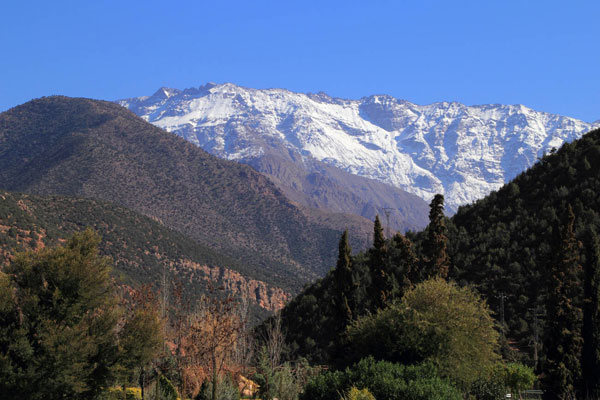
Key Highlights
- Mount Toubkal: The ultimate challenge and highlight, a two- to three-day trek that rewards climbers with panoramic views of the High Atlas and beyond.
- Imlil Village: The most popular base for hikers, with numerous guesthouses, guide services, mule rentals, and local shops.
- Azzaden and Ourika Valleys: Lush green oases contrasting with rocky peaks—ideal for day hikes or scenic drives.
- Traditional Amazigh Life: The park is dotted with mud-brick villages where locals still live as they have for generations—offering unique cultural encounters.
Activities
- Trekking & Hiking: From half-day walks to multi-day treks (Toubkal summit, Imlil to Setti Fatma, and circuit routes).
- Wildlife Spotting: Keep an eye out for wild boars, jackals, golden eagles, and Barbary sheep.
- Photography: Jaw-dropping mountain vistas, stone villages, terraced fields, and colorful sunrises.
- Cultural Immersion: Guided village tours, tea with local families, and overnight stays in traditional guesthouses or mountain refuges.
Best Time to Visit
- Spring (April–June): Wildflowers, green valleys, and mild weather.
- Autumn (September–October): Clear skies, cool temperatures—ideal for trekking.
- Winter (November–March): Snow covers the peaks—perfect for experienced mountaineers or snowshoe treks, but more demanding.
Tips for Visiting
- Hire a certified local guide, especially for the summit trek.
- Acclimatize properly to avoid altitude sickness.
- Pack layers—temperatures shift drastically from valleys to peaks.
- Support eco-friendly guesthouses that contribute to local conservation.
Why It’s Worth It
Toubkal National Park isn’t just a destination—it’s a journey. Whether you’re reaching the roof of North Africa, wandering through ancient paths, or sipping mint tea with a shepherd’s family, Toubkal offers an unforgettable blend of natural grandeur and human warmth. It’s a must for anyone who wants to experience the soul of Morocco’s wilderness.
2. Ifrane National Park: Morocco’s Cedar Forest Wonderland
Location: Middle Atlas Mountains, near the town of Ifrane
Established: 2004
Area: Approximately 500 km²
Overview
Nicknamed “Little Switzerland”, Ifrane National Park is a lush, high-altitude haven that feels a world apart from the deserts and medinas that most travelers associate with Morocco. The region’s crisp mountain air, alpine lakes, and wide cedar forests make it one of the country’s most peaceful and picturesque natural escapes.
This park is especially beloved for its enormous groves of Atlas cedar trees—some of the oldest and largest in North Africa—and as one of the last remaining habitats of the endangered Barbary macaque, a primate native to the region.
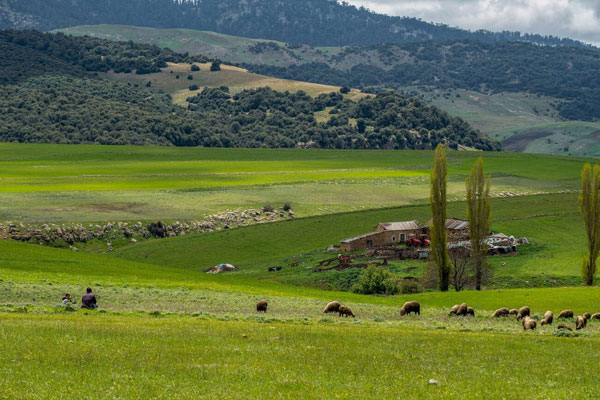
Key Highlights
- Cedre Gouraud Forest: Home to one of the largest and oldest cedar trees in Morocco, often surrounded by troops of Barbary macaques.
- Dayet Aoua and Dayet Ifrah Lakes: Beautiful alpine lakes surrounded by birds and pine forests—ideal for picnics and quiet walks.
- Seasonal Snowfalls: In winter, Ifrane and its surroundings are blanketed in snow, attracting Moroccan families and tourists looking for a snowy escape.
- The Town of Ifrane: A charming, European-style town with flower-lined avenues, red-roofed houses, and a reputation for cleanliness and calm.
Activities
- Wildlife Watching: Spot Barbary macaques, wild boars, foxes, and many bird species, including storks and woodpeckers.
- Hiking & Nature Walks: Easy to moderate trails through cedar and oak forests, meadows, and lake areas.
- Snow Play & Winter Sports: From December to February, enjoy snowball fights, sledding, or even skiing in nearby Michlifen resort.
- Photography: The contrast of snowy peaks, green forests, and peaceful lakes provides endless photo opportunities.
- Spring Wildflowers: In April and May, the region bursts into bloom with colorful alpine flora.
Best Time to Visit
- Spring (April–June): Lush green landscapes and mild temperatures.
- Autumn (September–October): Golden leaves, fewer crowds, and perfect hiking weather.
- Winter (December–February): For snow lovers, but bring warm clothing.
- Summer (July–August): Cool and refreshing—ideal for escaping Morocco’s city heat.
Tips for Visiting
- Be respectful of the macaques—do not feed them, and keep a safe distance.
- Dress in layers—mornings and evenings can be chilly, even in summer.
- Bring binoculars if you’re into birdwatching—many migratory birds pass through here.
- Combine with a visit to Azrou, a traditional market town nearby.
Why It’s Worth It
Ifrane National Park is the green heart of Morocco, offering tranquil beauty, rare wildlife, and a completely different side of the country. Whether you come for the forests, the macaques, or the chance to sip tea by a snowy lake, this park invites you to breathe deeply and slow down. It’s an ideal stop for families, nature photographers, and anyone craving a peaceful retreat into the wild.
Explore Morocco’s National Parks Today!
Ready to experience Morocco’s breathtaking landscapes and unique wildlife firsthand? Start planning your adventure now! Whether it’s hiking Toubkal, spotting Barbary macaques in Ifrane, or relaxing on Souss-Massa’s wild beaches, Morocco’s national parks have something unforgettable waiting for you.
Book your guided tour or eco-lodge stay today and step into the wild heart of Morocco!
3. Souss-Massa National Park: Morocco’s Coastal Wildlife Sanctuary
Location: South of Agadir, along the Atlantic coast
Established: 1991
Area: Approximately 330 km²
Overview
Souss-Massa National Park is a unique blend of wild Atlantic coastline, sandy dunes, wetlands, and steppe—a vital ecological zone that offers refuge to some of Morocco’s rarest wildlife. This park is internationally recognized for protecting the endangered Northern Bald Ibis, a bird once considered extinct in much of the world.
Unlike the mountainous parks of the Atlas, Souss-Massa offers a warmer, flatter, and more open landscape, making it easily accessible for casual visitors, families, and birdwatchers. It’s a rare spot where you can enjoy tranquil beaches, dramatic cliffs, and biological richness all in one peaceful setting.
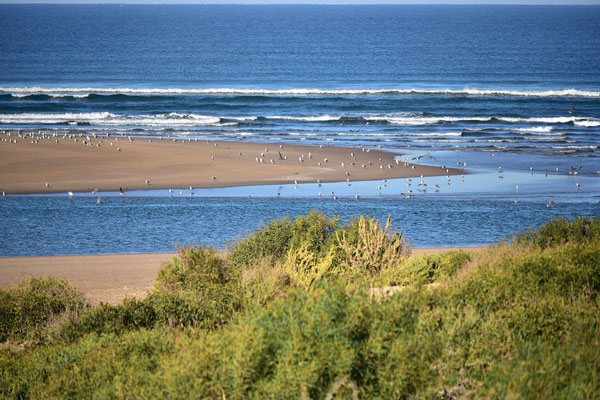
Key Highlights
- Northern Bald Ibis Colonies: One of the last strongholds of this critically endangered bird species. The cliffs near Tamri and Massa are key nesting areas.
- Massa River Estuary: A lush, green wetland contrasting with the surrounding arid land—rich in birdlife, especially during migration seasons.
- Atlantic Beaches and Cliffs: Wild and largely untouched, perfect for walks, picnics, and photography.
- Traditional Villages and Agriculture: Local Amazigh communities live within the park boundaries, offering insight into rural life.
Activities
- Birdwatching: Spot flamingos, herons, storks, egrets, marbled ducks, and bald ibises—especially in the Massa Lagoon and along the estuary.
- Walking and Easy Hikes: Flat, scenic trails along the coast and through agricultural lands and wetlands.
- Eco-Tours with Local Guides: Many local conservationists and naturalists offer guided birdwatching and educational tours.
- Beach Exploration: Visit wild beaches like Sidi Rbat, Tifnit, and Aglou—quiet, undeveloped, and full of character.
- Photography and Nature Observation: The park is a dream for landscape photographers and wildlife lovers.
Best Time to Visit
- Autumn and Spring (September–November, March–May): Best for bird migration, mild weather, and rich biodiversity.
- Winter (December–February): Pleasant coastal temperatures and high bird activity.
- Avoid peak summer afternoons, as it can get hot and dry, especially inland.
Tips for Visiting
- Bring binoculars and a camera with a zoom lens—many birds nest in cliffs or tall grasses.
- Hire a local guide—they know where and when to find specific species.
- Dress in light layers, wear a hat, and bring plenty of water and sunscreen.
- Visit in the early morning or late afternoon for the best birdwatching.
Why It’s Worth It
Souss-Massa National Park is not just about scenery—it’s about preservation. It’s one of Morocco’s most important efforts to protect biodiversity, especially coastal birds. For travelers interested in ecology, photography, or peaceful nature experiences near the ocean, this park is a hidden gem just a short drive from Agadir.
4. Talassemtane National Park: The Green Jewel of the Rif Mountains
Location: Near Chefchaouen, in the Rif Mountains of northern Morocco
Established: 2004
Area: Approximately 580 km²
Overview
Talassemtane National Park is a breathtaking expanse of rugged mountains, dense forests, waterfalls, and limestone cliffs in northern Morocco’s Rif region. It serves as a natural extension of the beauty and calm found in nearby Chefchaouen, the famous blue-painted town nestled at the park’s doorstep.
This park protects some of the last remaining fir and cedar forests in North Africa, along with a wide range of flora and fauna found nowhere else. With its dramatic terrain and unspoiled scenery, it’s a haven for hikers, nature photographers, and those looking to get off the beaten path in one of Morocco’s most peaceful corners.
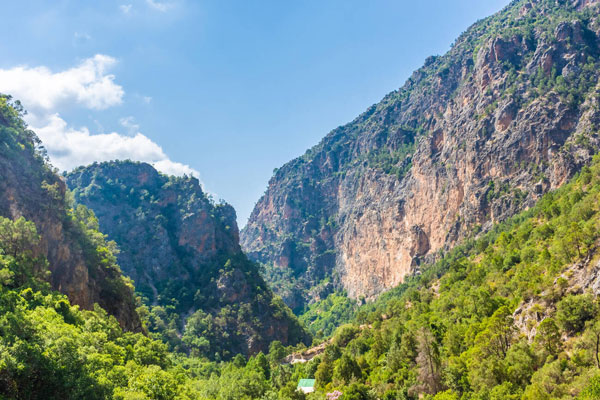
Key Highlights
- Spectacular Mountain Scenery: Towering cliffs, lush valleys, and panoramic views across the Rif Mountains.
- Cascades d’Akchour: A popular hiking destination within the park—crystal-clear waterfalls and pools perfect for swimming.
- Pont de Dieu (God’s Bridge): A natural stone arch carved by erosion over centuries—one of the park’s iconic geological features.
- Biodiversity Hotspot: Home to endangered trees like the Moroccan fir (Abies maroccana) and a variety of reptiles, birds, and mammals.
Activities
- Hiking & Trekking: From easy walks to multi-day treks—popular trails include:
- Akchour Waterfalls Hike (half-day)
- God’s Bridge Loop (moderate, with incredible views)
- Chefchaouen to Talassemtane village hikes
- Wildlife & Birdwatching: Look out for eagles, owls, wild boars, and reptiles.
- Swimming in Natural Pools: Cool off in spring-fed basins near the waterfalls, especially in summer.
- Camping & Picnicking: There are areas near Akchour ideal for relaxing and dining outdoors.
Best Time to Visit
- Spring (March–May): Lush green landscapes, wildflowers, flowing waterfalls.
- Autumn (September–October): Pleasant weather and fewer crowds.
- Summer (June–August): Warm but still cooler than lowland Morocco—great for water hikes.
- Winter (November–February): Quieter but trails may be muddy or less accessible.
Tips for Visiting
- Wear sturdy shoes—the terrain can be rocky and steep.
- Bring snacks and water—facilities inside the park are limited.
- Start hikes early to avoid afternoon heat and crowds, especially near Akchour.
- Respect the environment—carry out all waste, stay on marked trails, and do not disturb wildlife.
- Consider using local guides from Chefchaouen—they offer valuable insights and help support community tourism.
Why It’s Worth It
Talassemtane is one of Morocco’s most naturally stunning and tranquil escapes. With its dramatic cliffs, refreshing waterfalls, and rich forest cover, it feels like a secret paradise—especially when paired with a stay in nearby Chefchaouen. If you’re seeking a blend of mountain adventure and serene beauty, this park should be high on your list.
5. Al Hoceima National Park: Morocco’s Hidden Mediterranean Paradise
Location: Mediterranean coast near the city of Al Hoceima, in northern Morocco
Established: 2004
Area: Approximately 470 km² (including both land and marine zones)
Overview
Al Hoceima National Park is one of Morocco’s few coastal and marine national parks, offering a stunning combination of turquoise waters, steep limestone cliffs, hidden beaches, and rich marine biodiversity. Nestled between the Rif Mountains and the Mediterranean Sea, this park is a tranquil and relatively untouched escape that showcases a very different side of Morocco—Mediterranean, wild, and full of natural charm.
It’s ideal for those seeking a mix of seaside relaxation, hiking, and ecotourism. Much of the area is still unexplored by mass tourism, which means you’ll often have beaches or trails nearly to yourself.
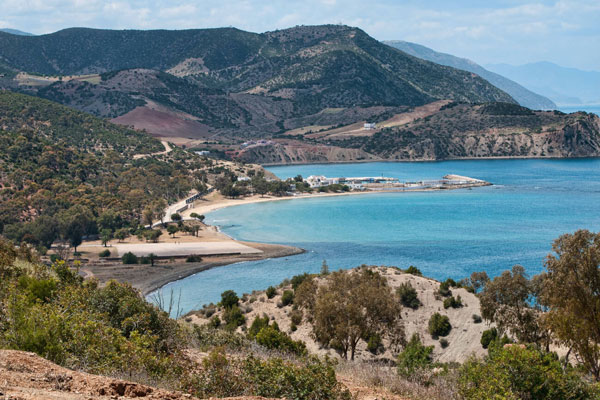
Key Highlights
- Cliffside Scenery: Towering white cliffs plunge into clear blue waters—perfect for dramatic coastal photography.
- Hidden Beaches and Coves: Many are only accessible by foot or boat, such as Plage Bades or Plage Cala Iris.
- Marine Biodiversity: Protected waters are home to dolphins, octopuses, groupers, and coral reefs.
- Rifian Culture: Small Amazigh fishing villages dot the coastline, offering local charm and hospitality.
Activities
- Hiking and Coastal Walks: Trails wind along cliff edges, through pine forests, and down to remote beaches.
- Snorkeling & Diving: Clear waters reveal colorful fish, coral beds, and submerged caves.
- Boating and Kayaking: Ideal for exploring coves, sea caves, and rocky outcrops inaccessible by land.
- Birdwatching & Wildlife Observation: Look for ospreys, Audouin’s gulls, and other coastal birds. Inland, you might see wild boars and reptiles.
Best Time to Visit
- Late Spring to Early Autumn (May–September): Ideal beach weather, calm waters for snorkeling and swimming.
- June & September: Great balance of warmth and fewer crowds.
- Avoid Winter Months (December–February) if you’re looking for water activities—the sea can be rough and chilly.
Tips for Visiting
- Bring snorkeling gear—rentals may not be available near more remote beaches.
- Many areas are unmarked and undeveloped—download offline maps and ask locals for guidance.
- Stay in Al Hoceima town for access to amenities, or opt for an eco-lodge or rural guesthouse for an immersive experience.
- Respect marine conservation rules—no fishing, littering, or disturbing wildlife in protected zones.
Why It’s Worth It
Al Hoceima National Park is a true hidden gem. It offers everything you’d expect from a Mediterranean paradise—cliffs, coves, sea breezes, and calm turquoise waters—but with a uniquely Moroccan flavor. It’s a park for explorers, nature lovers, and anyone who wants to relax somewhere beautiful, uncrowded, and untouched by mass tourism.
6. Dakhla National Park (Proposed): The Desert-Meets-Ocean Sanctuary of the South
Location: Dakhla Peninsula and surrounding areas, in Western Sahara (southern Morocco)
Status: Proposed national park / protected biosphere reserve (not yet fully formalized)
Area: Estimated to be over 1,000 km² including the bay, wetlands, dunes, and desert zones
Overview
Dakhla is unlike anywhere else in Morocco—a unique ecological crossroads where Sahara desert landscapes meet the Atlantic Ocean in dramatic style. While not officially designated a national park yet, the Dakhla region is considered an ecological priority due to its biodiversity, sensitive ecosystems, and rising potential for eco-tourism.
This remote area is rich in wetlands, lagoons, sand dunes, and desert plains, making it a key site for migratory birds, marine life, and adventure tourism. It is currently under consideration for full national park status and already protected as part of the Dakhla Bay-Rio de Oro Biosphere Reserve, recognized by UNESCO.
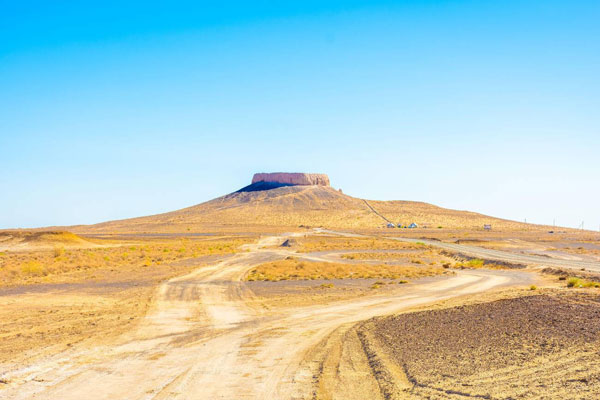
Key Highlights
- Dakhla Bay: A vast, shallow bay with warm, nutrient-rich waters—perfect for marine wildlife and water sports.
- Migratory Birds: Home to flamingos, spoonbills, herons, and countless waders that stop here en route between Europe and sub-Saharan Africa.
- Desert and Dune Landscapes: Towering dunes meet the sea in surreal, cinematic fashion.
- Marine Mammals: Occasionally visited by dolphins and seals; the bay is ecologically vital for fish nurseries and aquatic life.
Activities
- Birdwatching: One of the best birding sites in North Africa, especially between October and March.
- Kitesurfing & Windsurfing: World-famous for consistent trade winds and flat waters—hosts international competitions.
- Eco-Tours & Desert Safaris: Explore the desert coastlines, hot springs, and vast dunes on camelback or 4×4 tours.
- Kayaking & Boating: Gentle bay waters are ideal for paddling and observing marine life up close.
- Camping Under the Stars: Desert camping in luxury eco-lodges or wild sites near the ocean.
Best Time to Visit
- October to April: Cooler temperatures and peak bird migration season.
- Summer (June–August): Hot inland but pleasant along the coast due to Atlantic breezes.
Tips for Visiting
- Choose eco-conscious lodges and tour operators—this fragile environment depends on responsible tourism.
- Dress in layers—the desert can be hot by day and cool by night.
- Bring binoculars and a camera for bird and desert photography.
- Avoid disturbing wildlife or vegetation—especially around nesting areas.
Why It’s Worth It
Dakhla represents the future of eco-tourism in Morocco—an untouched corner of the country where nature still dominates the landscape. It’s ideal for travelers seeking solitude, adventure, or a deep connection with vast, open environments. Whether you’re watching flamingos take flight at dawn or windsurfing across mirror-like waters, Dakhla offers moments of magic that you won’t find anywhere else in the country.
Explore Morocco’s National Parks Today!
Ready to experience Morocco’s breathtaking landscapes and unique wildlife firsthand? Start planning your adventure now! Whether it’s hiking Toubkal, spotting Barbary macaques in Ifrane, or relaxing on Souss-Massa’s wild beaches, Morocco’s national parks have something unforgettable waiting for you.
Book your guided tour or eco-lodge stay today and step into the wild heart of Morocco!
What to Know Before Visiting Morocco’s National Parks
Exploring Morocco’s national parks can be one of the most rewarding parts of your trip—but it’s important to plan ahead. From navigating trails to respecting local customs and environmental rules, this section will help you get the most out of your adventure while traveling responsibly.
1. Park Access and Infrastructure Vary Widely
Not all Moroccan national parks are created equal in terms of infrastructure.
- Parks like Toubkal and Ifrane have well-marked trails, visitor facilities, and accessible base towns (like Imlil and Ifrane).
- Others, like Talassemtane or Al Hoceima, are wilder and less formalized—beautiful but often lacking signage or ranger stations.
- Souss-Massa is flat and easier to navigate, while Dakhla requires more planning due to its remote location.
Tip: Research your park in advance and consider using local guides for off-the-beaten-path areas.
2. Best Time to Visit
Morocco’s climate varies by region, so timing your visit to the parks is essential.
|
Season |
Best Parks to Visit |
Notes |
|
Spring |
All parks (especially Toubkal, Ifrane, Souss-Massa) |
Wildflowers, flowing rivers, active wildlife |
|
Summer |
Al Hoceima, Souss-Massa, Dakhla |
Cooler coastal parks; avoid high-altitude or inland parks at midday |
|
Autumn |
Talassemtane, Toubkal, Ifrane |
Clear weather, fewer tourists, great for trekking |
|
Winter |
Souss-Massa, Dakhla (birding); Toubkal (snow hikes) |
Cold/snowy in mountains; coastal parks are mild and pleasant |
Tip: Avoid hiking in extreme summer heat or venturing into remote trails during heavy rains (especially in the mountains).
3. What to Pack
Here’s what you should bring for a comfortable and responsible visit:
- Sturdy hiking boots or trail shoes
- Weather-appropriate layers (mornings and evenings can be cold, even in summer)
- Reusable water bottle (to avoid plastic waste)
- Sun protection (hat, sunscreen, sunglasses)
- Binoculars & camera (especially for birding parks)
- Maps and offline GPS apps (like Maps.me or Gaia GPS)
- Snacks and emergency items if you’re venturing far from towns
Optional: Trekking poles, bathing suit (for waterfalls or coastal parks), a small first aid kit.
4. Respect Nature and Local Communities
Moroccan parks are not just natural spaces—they are often home to local Amazigh (Berber) communities, especially in the Atlas and Rif mountains.
- Do not litter. Bring all waste out with you.
- Avoid feeding or disturbing wildlife, including monkeys and birds.
- Stay on marked trails to protect fragile plant life and reduce erosion.
- Ask permission before taking photos of people or private homes.
- Buy local. Support communities by purchasing handmade goods or hiring certified local guides.
Tip: Many guesthouses and eco-lodges contribute to conservation—choose these over mass-tourism resorts when possible.
5. Safety and Health
- Morocco is generally safe, but mobile coverage is limited in remote areas—always let someone know your route.
- In summer, dehydration and heat exhaustion are real risks. Hydrate often and rest in the shade.
- For mountain hikes, especially to high peaks like Toubkal, acclimatize to altitude and travel with a guide.
Emergency Numbers:
- General Emergency: 19 or 112
- Mountain Rescue (via Gendarmerie): Ask local lodges or guides to contact them.
6. Park Fees and Guides
- Most parks do not have formal entry fees, though some (like Toubkal) request small contributions to local associations.
- Hiring a local guide is affordable, enriching, and often the safest way to explore deeper routes.
- In places like Souss-Massa, certified ecotourism organizations offer birding or nature walks.
Responsible Travel and Conservation in Morocco’s National Parks
Exploring Morocco’s stunning national parks comes with a responsibility: to protect these fragile ecosystems and support the local communities that live alongside them. Tourism can be a powerful force for good when done thoughtfully, and your choices as a traveler make a real difference.
1. Support Local Conservation Efforts
Many national parks in Morocco are managed in collaboration with local communities, conservation groups, and government agencies. Entrance fees, guided tours, and eco-friendly accommodations often help fund wildlife protection, reforestation projects, and environmental education.
- Choose certified local guides who know the area and its challenges.
- Stay in eco-lodges, riads, or guesthouses that prioritize sustainable practices.
- Participate in community-led activities like reforestation or clean-up days when available.
2. Minimize Your Environmental Impact
- Stick to marked trails to avoid trampling sensitive vegetation.
- Carry out all your trash — including biodegradable waste like fruit peels.
- Use reusable water bottles and avoid single-use plastics.
- Use biodegradable soaps and shampoos if camping or staying in rural areas.
- Avoid disturbing wildlife: don’t feed animals, approach cautiously, and keep noise levels low.
3. Respect Local Cultures and Traditions
Many national parks are home to Amazigh (Berber) villages with rich traditions. Respect their privacy, customs, and daily life by:
- Asking permission before photographing people or their homes.
- Learning a few words of Tamazight or Arabic — greetings and thanks go a long way.
- Supporting local artisans by purchasing handmade crafts directly from producers.
- Being mindful of religious or cultural events and dress codes, especially in rural areas.
4. Travel Off-Season or to Lesser-Known Parks
To reduce overcrowding and lessen environmental strain:
- Consider visiting parks during shoulder seasons (spring and autumn).
- Explore lesser-visited parks like Talassemtane or Al Hoceima.
- Avoid popular peak times in Toubkal and Ifrane if you prefer solitude and a lighter footprint.
5. Educate Yourself and Others
- Learn about the flora, fauna, and challenges each park faces.
- Share your positive experiences and tips on responsible travel.
- Encourage fellow travelers to respect the environment and communities they visit.
Why This Matters
Morocco’s national parks are living, breathing ecosystems that support countless species and provide livelihoods to many people. Thoughtful, respectful tourism ensures these treasures will remain vibrant and protected for generations to come — including your own future visits.
Final Thoughts: Embrace the Natural Wonders of Morocco
Morocco is often celebrated for its vibrant cities, historic sites, and desert landscapes—but its national parks reveal a different, equally captivating side of the country. From the towering peaks of the High Atlas to the lush cedar forests of Ifrane, from the wild Atlantic coastlines of Souss-Massa to the hidden Mediterranean coves of Al Hoceima, Morocco’s protected natural areas offer adventure, tranquility, and a deep connection to the land.
Exploring these parks allows you to witness rare wildlife, hike ancient trails, and experience the warmth of Amazigh culture far from the usual tourist paths. Whether you’re summiting Mount Toubkal, spotting the endangered bald ibis, or simply soaking in a mountain waterfall, Morocco’s national parks provide unforgettable experiences that enrich any travel itinerary.
By visiting these parks responsibly, supporting local communities, and treading lightly on the environment, you become part of Morocco’s story of conservation and sustainable tourism. So next time you plan a Moroccan adventure, don’t just see the cities—venture into the wild, breathe in the fresh mountain air, and discover the extraordinary natural treasures waiting for you.
